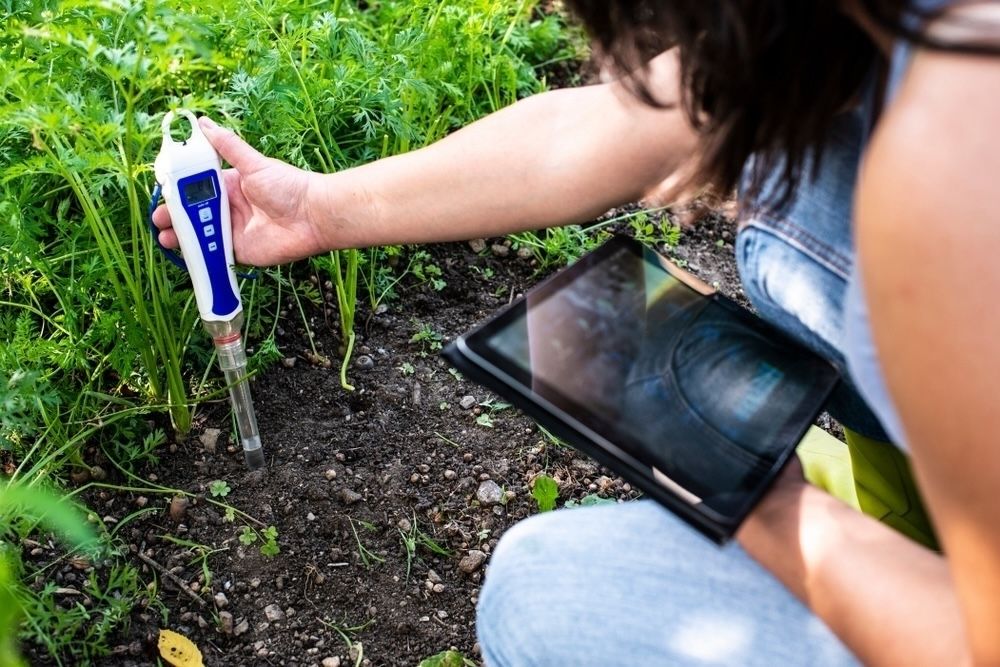Understanding Soil pH for Thriving Plants

Soil pH is one of the most crucial yet often overlooked aspects of gardening. The pH level of your soil is a measure of its acidity or alkalinity, and it plays a vital role in determining how well your plants can access essential nutrients. A soil's pH can influence many factors, including nutrient availability, microbial activity, and overall plant health, making it a fundamental aspect of successful gardening.
For experienced gardeners, fine-tuning soil pH can mean the difference between a good harvest and a great one. When soil pH is within the optimal range for a particular plant, nutrients are more readily available, and plants can absorb them more efficiently. Conversely, when soil pH is too high or too low, certain nutrients can become locked up and unavailable, leading to deficiencies and poor plant performance.
Microbial activity in the soil is also highly dependent on pH levels. Beneficial microbes that decompose organic matter and release nutrients are most active in soils with a pH between 6 and 7. If the pH drifts outside this range, microbial processes can slow down, impacting soil fertility and structure. This can affect everything from the health of the root system to the ability of plants to withstand diseases and pests.
For beginners, understanding soil pH might seem daunting, but it doesn't have to be. Basic knowledge of how to test and adjust soil pH can transform your gardening results dramatically. By regularly testing your soil and making necessary adjustments, you can create an optimal growing environment for your plants. Whether you're planting a vegetable garden, nurturing ornamental flowers, or maintaining a lush lawn, managing soil pH is a critical step in ensuring that your plants thrive.
What is Soil pH?
Soil pH measures the acidity or alkalinity of the soil, ranging from 0 to 14, with 7 being neutral. Soils with a pH below 7 are acidic, while those above 7 are alkaline. Most plants prefer a slightly acidic to neutral pH (6.0-7.0), but some thrive in more specific pH ranges.
The pH scale is logarithmic, meaning each whole number on the scale represents a tenfold difference in acidity or alkalinity. For example, soil with a pH of 5 is ten times more acidic than soil with a pH of 6. Understanding this can help gardeners appreciate the significant impact even small pH changes can have on their plants.

Why is Soil pH Important?
Nutrient Availability
The pH level of your soil affects the availability of essential nutrients. For instance, in highly acidic soils, elements like aluminum and manganese can become toxic, while phosphorus becomes less available. Conversely, in alkaline soils, iron, zinc, and copper may be deficient. These imbalances can lead to poor plant growth, yellowing leaves, and reduced yields.
Understanding nutrient availability in relation to soil pH can guide gardeners in making better fertilizer choices. For example, in acidic soils, using lime not only raises the pH but also makes nutrients like phosphorus more available. Conversely, in alkaline soils, adding organic matter can help increase the availability of micronutrients.
Microbial Activity
Beneficial soil microbes, which decompose organic matter and release nutrients, are most active in a pH range of 6-7. Extreme pH levels can hinder their activity, affecting soil health and plant growth. Microbes play a critical role in the nitrogen cycle, breaking down organic matter into forms that plants can absorb. In highly acidic or alkaline soils, microbial processes slow down, leading to nutrient deficiencies and poorer soil structure.
Moreover, specific microbes that form symbiotic relationships with plants, such as mycorrhizal fungi, thrive within optimal pH ranges. These fungi extend the root system's reach, helping plants absorb water and nutrients more efficiently. Maintaining a balanced pH supports these beneficial relationships.
Plant Health
Certain plants have adapted to thrive in specific pH ranges. Blueberries, for example, prefer acidic soils (pH 4.5-5.5), while lavender favors slightly alkaline soils (pH 7.0-8.0). Planting in the right soil pH ensures optimal growth and productivity. Misalignment between plant preferences and soil pH can result in stunted growth, poor flowering, and increased susceptibility to diseases.
Gardeners can leverage soil pH knowledge to create specialized garden areas. Acid-loving plants can be grouped together, while those preferring alkaline conditions can be planted in another section. This approach not only meets plants' needs but also simplifies soil management practices.

How to Test Soil pH
Testing your soil pH is straightforward and can be done using several methods:
Soil pH Test Kits
Available at garden centers, these kits provide a quick and easy way to test soil pH. Simply mix soil with water and a testing solution, then compare the color change to a pH scale. These kits are user-friendly and provide instant results, making them ideal for home gardeners.
When using a soil pH test kit, it's important to take samples from different parts of your garden to get an accurate overall reading. Soil composition can vary significantly within short distances, especially in larger gardens or areas with varied planting histories.
pH Meters
These electronic devices provide instant pH readings. Insert the probe into the soil and read the pH level on the display. pH meters are reusable and offer precise measurements, making them a valuable tool for serious gardeners. They are also useful for regular monitoring, helping gardeners track changes over time.
Maintaining the accuracy of pH meters involves regular calibration using standard solutions. Proper care and storage of the probe are essential to ensure long-term functionality and reliable readings.

Professional Testing
For more accurate results, consider sending a soil sample to a laboratory. This option provides detailed information about your soil's pH and nutrient levels. Professional testing is particularly useful for gardeners dealing with persistent soil issues or planning major landscaping projects.
Laboratories can also provide recommendations for soil amendments based on the specific needs of your garden. This tailored advice can help you make informed decisions about how to adjust your soil pH and improve overall soil health.
Adjusting Soil pH
Once you know your soil's pH, you can take steps to adjust it if necessary:
Lowering pH (Acidifying Soil)
Add sulfur or organic matter like peat moss to lower soil pH. Sulfur reacts with soil bacteria to form sulfuric acid, reducing pH. Organic matter decomposes, releasing organic acids that also lower pH. This process can take several months, so it's important to plan ahead and apply amendments well before planting season.
Regular applications of organic matter, such as compost or mulch, can help maintain a slightly acidic pH over time. Additionally, using acidifying fertilizers, like ammonium sulfate, can further support acid-loving plants.
Raising pH (Alkalizing Soil)
Add lime (calcium carbonate) to raise soil pH. Lime neutralizes soil acidity, making it more alkaline. Wood ash can also be used but should be applied cautiously to avoid over-alkalization. Lime is available in several forms, including ground limestone, hydrated lime, and pelletized lime, each with different application rates and effectiveness.
It's crucial to follow application guidelines and avoid over-liming, which can lead to excessively alkaline soils. Gradual adjustments are more manageable and reduce the risk of nutrient imbalances.

Maintaining Optimal Soil pH
Maintaining the optimal soil pH for your garden involves more than just an initial adjustment; it requires ongoing attention and care. Regular soil testing is essential to keep track of your soil’s pH levels and ensure they remain within the desired range for your plants. By testing your soil at least once or twice a year, you can catch any deviations early and make the necessary corrections before they impact plant health.
Incorporating organic matter into your soil is one of the most effective ways to help stabilize pH levels. Organic matter, such as compost, manure, and leaf mold, can buffer soil pH, making it more resistant to drastic changes. This not only improves soil structure and fertility but also provides a steady supply of nutrients as it decomposes. Regularly adding organic matter can create a more resilient and balanced soil environment.
Using pH-neutral fertilizers is another key strategy. Many commercial fertilizers can alter soil pH, sometimes leading to unintended shifts that can harm plant growth. Opting for pH-neutral fertilizers ensures that you’re feeding your plants without disrupting the soil’s pH balance. Additionally, avoiding excessive chemical amendments can prevent rapid and unpredictable changes in soil pH. Instead, consider natural soil amendments and conditioners, which tend to have a more gradual and controlled effect on pH levels.
Mulching is a beneficial practice that can contribute to maintaining optimal soil pH. Mulch helps retain moisture, suppress weeds, and add organic matter as it breaks down. Organic mulches, such as straw, wood chips, and grass clippings, gradually decompose, adding nutrients and helping to buffer soil pH. Additionally, mulching can protect soil from erosion and extreme temperature fluctuations, both of which can affect soil pH.
Crop rotation is another effective technique for maintaining soil health and pH balance. Different plants have varying pH preferences and nutrient requirements. By rotating crops with different pH needs, you can prevent the depletion of specific nutrients and avoid pH imbalances. For example, following a heavy feeder with a legume crop can help replenish nitrogen levels in the soil, promoting a more balanced pH.
Gardeners should also be aware of the natural pH changes that occur over time due to factors such as weathering, leaching, and organic matter decomposition. Rainfall, for instance, can leach away basic ions, gradually acidifying the soil. Similarly, the decomposition of organic matter can release organic acids, influencing soil pH. Continuous monitoring and proactive soil management practices, such as adjusting soil amendments and fertilization schedules, will ensure that your plants thrive in a balanced pH environment.
Ensuring Success Through Soil pH Management
Understanding and managing soil pH is vital for any gardener aiming for a thriving garden. By ensuring your plants are growing in the right pH environment, you can maximize nutrient availability, boost microbial activity, and promote robust plant health.
A well-maintained soil pH not only enhances the immediate growing conditions but also contributes to the long-term health of your garden. Plants grown in the right pH range are more resilient, produce better yields, and exhibit more vibrant colors and stronger growth. The benefits extend beyond individual plants to the entire garden ecosystem, fostering a harmonious balance where both plants and beneficial soil organisms can flourish.
Taking the time to regularly test and adjust your soil pH is a proactive step that can prevent many common gardening problems. Issues such as nutrient deficiencies, poor plant growth, and increased susceptibility to pests and diseases are often linked to improper soil pH. By addressing pH issues promptly, you create a foundation for a healthier and more productive garden.
Incorporating organic matter, using pH-neutral fertilizers, and practicing techniques like mulching and crop rotation can help maintain this balance. These practices not only stabilize soil pH but also improve soil structure, fertility, and overall garden sustainability. As you continue to care for your soil, you'll find that your plants are better able to take advantage of the nutrients and conditions you provide.
Remember, gardening is an ongoing learning process, and managing soil pH is a key aspect of that journey. Whether you are a novice or an experienced gardener, staying informed and adapting your practices to meet the needs of your soil and plants will yield rewarding results. Your efforts will be reflected in the health and beauty of your garden, providing you with a bountiful and enjoyable gardening experience. Happy gardening!
Check more articles on our blog

Unlocking the Secrets of No-Dig Gardening

Worm Castings: Perfect Natural Fertilizer for Gardens

8 Different Ways You Can Use Coffee Grounds in Your Home
